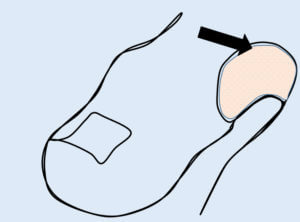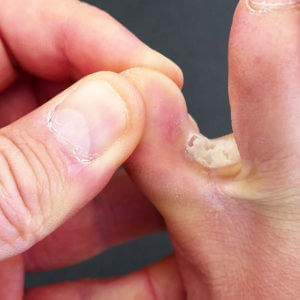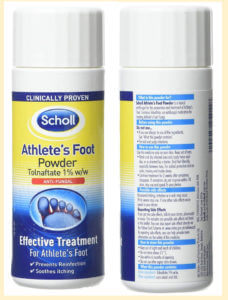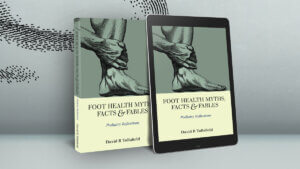The Irritating Little Toe
That irritating little toe looks like Athlete’s foot, but it isn’t. Treat yourself without fuss. Read more.
In this self-help article, the irritating little toe problem is discussed. Usually, the problem will settle within a week of self-prescribed care. I have chosen this subject because the condition differs slightly from the usual fungal infection affecting the toe. Before panicking and thinking you are unclean, read this article from ConsultingFootPain.
The patient looked down at his toe and saw flaky skin – white and raw. It itched madly, had an odour, and so it was assumed that dastardly condition toe fungus. The condition has various names, including Dhobi’s itch. The latter term relates more to irritation in the groin and areas where sweat builds up. Athlete’s feet are more commonly attributed to this condition and have a fungus rather than bacterial origin.
While athlete’s foot (dermatomycosis) is associated with warm climates, it can affect us in winter as well as summer, all because we fail to dry in an area susceptible to the problem (see diagrams below). This annoying condition affects the small toe, or to be more precise affects the inside cleft of the fifth toe. Full-blown fungal infections can have a ring-like feature (ringworm) and affect skin across the foot and other parts of the body. Blisters emerge as small vesicles which predominate the sole and arch in particular. Nails are also affected by fungus but may take much longer to arrive, and treatment is often more prolonged. Refer to the resources below for more information.
But what about an isolated toe …

The deep basin collects moisture (arrow)
The little toe or fifth toe has a cup shape indent toward the base as it connects with the foot. The cup acts to trap water if the area is not dried. The skin becomes soggy (macerated – see picture) and sets up an irritation within a short period. If the skin surface (epidermis) sheds back or flakes, the lower layer is exposed and cannot combat fungus or bacteria well. The change in odour is noticeable and confined to the scooped-out shape. Often by the time the person notices the problem has hatched.
What to do about the itchy damage?
Open the toes to locate the source of the irritation. This arises as an itch and stinging sensation. You will find this as an isolated feature affecting one or both feet. Wash the foot and dry this vigorously with a small towel only used by yourself. The typical appearance is shown below and is often assumed to be fungal in origin. The skin will flake away, leaving a moderate tender area, so you may not be able to be as vigorous as you might wish. Dry gently with a dryer set at a temperature that does not burn.

Shutterstock.com
While an alcohol-based preparation in the form of surgical spirit was traditional and would help dry the toe, you can try using the antiperspirant under your arms. This way, you should know if you are sensitive, but the spray will act in the same way as the alcohol agent and have a pleasant odour. A slight discomfort is noted while the base skin is still raw. You can conveniently use this several times a day (2-3)
Light rather than a heavy dusting of talc
The use of a talcum-type powder treated with an anti-fungal agent is important rather than ordinary cosmetic talc. This dries the base. I have used a picture above from a well-known company, but other preparations are available, and the type depicted is not a recommendation for a specific brand. Alternative sprays come as powder and dry, e.g Daktarin Aktiv (note available in the UK and may not be the same products in the USA or Australia).

Tolnaftate Powder.

Antifungal spray powder.
Don’t forget your footwear and socks.
Ensure socks or tights are used only if necessary for the first two days to allow better air circulation. Clearly, in winter, this is impractical outside the house. Use footwear such as sandals and flip-flops to improve air to the feet. Clean the toe off at night and retreat in the morning. Don’t pile blankets on (winter) to superheat your feet. Each time you treat the skin, wash, dry and rub as vigorously as you can. Once the loose skin is removed by rubbing, the skin will heal and form a new layer. By the end of the first week (5 days), the toe should be more comfortable and start to resolve. Complete resolution may take 10 days.
The cause of the irritating little toe
The shape of the toe at its base does not allow automatic drying. The deeper the cup (coloured pink in the diagram), the higher the risk of this affliction. Scrupulous regular drying prevents this, while failure to act can lead to maceration quickly. The condition is often populated with bacteria rather than fungal infections. Still, if left, the fungal (mycotic) infection can follow, causing the toe to split and the skin to develop a red rash. Bacteria are frequently the reason for the unpleasant smell as they give off chemicals that create an offensive odour. The NHS link is excellent for more advice and goes into other types of concerns.
This author has tested the method above, and is safe bar the discomfort that arises for a short time when spraying onto the raw surface. The alcohol propellant and dusting powder dry the skin after the flakes are removed by rubbing. If the condition does not settle and persists beyond 7 days without showing signs of improvement, then seek professional podiatric or medical help. Check the resource centres below.
CAUTION:
Diabetics, those who cannot reach their feet, and people at risk from immunosuppressive treatment should seek advice earlier before self-treating this condition
Other resource centres
NHS advice: Link
Footeducation: Link
Institute of Chiropodists & Podiatrists: Link
Please note these links can change as information is updated and outside our control

You can now read Foot Health Myths Facts & Fables by David R Tollafield, published at Amazon books
Thanks for reading ‘The Irritating Little Toe’ by David R Tollafield
Why not read – Podiatry as a career choice?
Published by Busypencilcase Communications Est. 2015 for ConsultingFootPain

Updated 23 June 2023

Sir I have same problem but I have got a inner wound type like a joint inside feeling I am trying to cut it by my hand to the dry skin its not happening I feel pain when I touch their I can not wear a shoe or a sandal
Roshan, it sounds like you should consult a professional specialising in foot care, as self-cutting is dangerous, and the area is open to a risk of infection. Interdigital infection is dangerous as the lymphatic system can take infection through the foot upward, making septicaemia a life-threatening risk. My article was written for the occasional problem while your foot problem sounds chronic. Do act now. David
please update
The reply might well have been blind as we sometimes communicate via email, but the general advice is to seek help as cutting the skin in between toes can lead to infection.
David